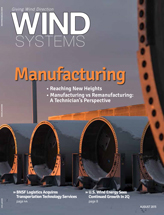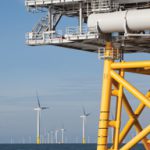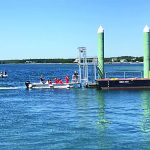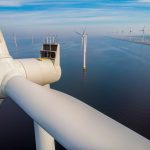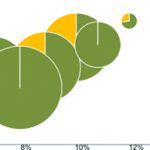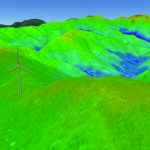Over the next 18 months or so, the U.S. utility-scale wind energy industry is expecting a burst of activity leading to around 11 GW of new installed capacity — due largely to regulations associated with the federal Production Tax Credit.
Along with the boom comes an operations and maintenance market that will experience strong continued growth — even beyond what is expected to be a temporary boost in the overall market. This growth in the O&M segment is being driven by fierce competition as OEMs and independent service providers vie for the business.U.S.–based manufacturers of wind turbines and associated components are benefitting in the short-term from the PTC-driven activity, as well. Current efforts in research and development are seeking to insure wind’s competitiveness and marketability for the long term — lowering the cost of wind by boosting efficiency with advances in blade and tower technologies. The construction segment of the industry is busy building and commissioning the current 11-GW pipeline of wind projects in order to meet PTC deadlines.
 The bubble of activity is due to the federal PTC, which has been extended twice since 2013 — at the beginning of 2013 and the end of 2014, explained Ryan Moody, MAKE’s market analyst for North America. The 2014 extension required developers to begin construction or invest at least 5 percent of the total project costs by the end of 2014 and commission the projects by the end of 2016. It’s possible some developers will be allowed to commission their projects after 2016 if they can prove they made continuous efforts to move the projects forward, Moody noted.
The bubble of activity is due to the federal PTC, which has been extended twice since 2013 — at the beginning of 2013 and the end of 2014, explained Ryan Moody, MAKE’s market analyst for North America. The 2014 extension required developers to begin construction or invest at least 5 percent of the total project costs by the end of 2014 and commission the projects by the end of 2016. It’s possible some developers will be allowed to commission their projects after 2016 if they can prove they made continuous efforts to move the projects forward, Moody noted.
Over the long-term, analysts expect a drop in the market in 2017, assuming the PTC is not extended. “Absent the PTC, the market will re-adjust, and there will be slight increases in 2018 and 2019 before we get to what we think will be a normal market without the PTC: 4.5 to 5 GW a year starting around 2020,” Moody said.
It’s still possible that the PTC will be extended, providing a continued boost to the market and lowering the cost of wind power by about $0.02/kWh, said Bruce Hamilton, a director in Navigant Consulting’s energy practice. A tax extenders bill — which was used last year to extend the PTC — is expected to come up in Congress later this year, he said, noting that wind energy is a bipartisan issue, with some Republican states benefitting from the wind industry.
Some argue that a number of factors will significantly dampen growth if the PTC is not extended.
“With a combination of low fuel prices, natural gas, and an abundance of renewables that have already been built, utilities are not inclined to enter into attractive power purchase agreements for new wind projects,” said Mike Lorusso, managing director and group head of CIT Energy.
Over the short-term, much of the activity is in Texas. Sixty-one percent of projects now under construction are located in Texas, said Hamilton. While Texas has met its RPS requirements, the projects are still competitive due to a number of factors, including the Competitive Renewable Energy Zone (CREZ), which put much-needed transmission in place for renewable projects. In addition, as part of its renewable portfolio standard, Texas created a market for renewable energy credits. However, the Texas market is becoming saturated, and is expected to drop off after the short-term boom, Hamilton said.
As of Jan. 1, 12.8 GW of projects were underway, according to a U.S. wind market forecast for 2015-2016 by Navigant. Of those projects, 9.4 MW had signed power purchase agreements.
Based on a quarter-by-quarter analysis, Navigant projected that 8.5 GW will be installed in 2015 and 6.3 GW will be installed in 2016.
Markets other than Texas are expected to grow in the long-term as states enact or boost their renewable portfolio standards.
“The state RPS standards are a key piece of demand,” Moody said. “Hawaii just went to 100 percent renewables and Vermont went to 75 percent. New York and California will increase their renewable energy targets as well.”
Retirements of coal plants also play an important role in the market.
Over the long term, Navigant predicts 11 to 14 GW will be installed in the Midwest in the next 10 years as a result of retirements of coal plants and RPS requirements. In addition, 5–8 GW will be installed in the Mid-Atlantic as the result of coal retirements, RPS, and about 2 GW of offshore projects. And 2–5 GW will be installed in California between 2015 and 2023, the report said, noting that absent a PTC, the market will be driven almost exclusively by RPS requirements.
Wind energy will provide 15-30 percent of new generation by 2024 without the PTC or 40 percent to 60 percent with the PTC, according to Navigant.
“The total 2015-2024 U.S. wind market will be 47 GW without the PTC and 62 GW with the PTC,” Navigant reported.
Over both the short-term and long-term, one of the most promising markets is O&M. With wind turbine warranties generally running between two and five years, the number of turbines near or at the end-of-warranty period is growing rapidly. That creates a huge market for those who can repair and maintain turbine gearboxes, generators, blades, brakes, and other turbine systems, subsystems, and components.
“It’s a huge and very lucrative business and there are a growing number of third-party providers,” said Alan Merkle, a partner with Stoel Rives who specializes in wind development. “The OEMs recognize it as a very important market.” Competition is fierce among the parties offering O&M, he added.
Calculating the size of the market is pretty simple, Hamilton said. For each GW of installed capacity, between 14.3  million and 20.8 million Euros are spent each year on O&M.
million and 20.8 million Euros are spent each year on O&M.
Navigant’s 2013 World Market Update spelled out the potential worldwide market. More than half of the 314 GW of onshore wind requiring service and maintenance was off warrantee at that time. “Demand for O&M services from original wind equipment manufacturers (OEMs) and independent service providers (ISPs) is expected to grow at 40 GW a year from 2013 onward,” the report said. “By the end of 2018, the volume of megawatt off-warranty (globally) will have reached 354.6 GW, representing a total market value of at least €5.1 billion (approximately $5.5 billion).”
As warranties expire, the wind operators can choose between re-signing contracts with OEMs, maintaining their systems in-house, or signing with a growing number of independent service providers.
O&M providers are focused on finding new ways for owners to invest in O&M, said Dalen Copeland, vice president of business development, EDF Renewable Energy. That includes finding ways to extract more energy yield from turbines and making sure the turbines are capturing as much energy as they can, she said.
In addition, O&M providers are offering supply chain management, data management, SCADA integration, and automation of reporting and faults and resets.
Some new offerings may lead to the need for additional maintenance she noted. For example, GE offers a power boost system, as do other companies.
“Those kinds of improvements which are largely (to my lay person knowledge) changes in operating parameters on the machines may have resultant impacts on the life of various hardware components of the machines not yet fully understood,” Copeland said.
EDF has not yet moved into the re-engineering of components or control parameters, Copeland said. “It could be the future, though,” she said.
Like O&M efforts, extracting more energy yield from turbines is the focus of R&D efforts over the next 18 months and beyond. Researchers are developing longer blades that allow turbines to produce electricity from wind a larger percentage of time. A major focus is working to balance the extra cost with the efficiency gains, said Eric Lantz, senior analyst at the National Renewable Energy Lab. In addition, higher towers increase production by allowing bigger winds to be captured without interference from trees.
Early forms of these advances may have been incorporated into some turbines now being installed to meet the PTC requirements, but most likely will be installed in the next few years, Lantz said.
The longer-blade, bigger-tower systems yield a jump in efficiency. Five years ago, turbines had capacity factors in the 30 – 40 percent range, meaning they were operating at maximum potential 30 – 40 percent of the time. Today, projects on good sites yield 40 – 50 percent, he said. The higher capacity factors are a “game changer” for the wind industry, he said. The developments have been implemented incrementally, and are expected to continue for the next few years. At that point, Lantz said, it depends on whether the costs outweigh the benefits.
Research is now underway in North Dakota to cut the costs associated with maintaining wind systems by using drones to inspect wind turbines, thanks to a $450,000 grant from the state.
Under the project, high-quality video is captured to provide data about the need for blade maintenance. That’s a lot more efficient and safe than having technicians climb up towers and rappel down the side of a blade to gather information, said Greg Thorsteinson, president of EdgeData, which collects and analyzes the data. A test of this system is now underway at a private wind farm in Massachusetts, he said. The drones cut about 8 hours of work for each turbine inspection, he said. The drones are expected to yield a five-to-ten fold reduction in costs, he said.
The costs are only one part of equation, he noted. “Timely and appropriate maintenance stemming from inspection results can result in lower repair costs, higher efficiency operation and even extend the life of the equipment.”
In the long term, “talking wind turbines” are on the horizon. They’re now being studied by the U.S. Department of Energy’s wind program under its Atmosphere to Electrons initiative.
The program aims to reduce the cost of wind energy “through an improved understanding of the complex physics governing wind flow into and through wind farms,” explained Noah Golding, a spokesman for the DOE.
“Better insight into the flow physics has the potential to reduce wind farm energy losses by up to 20 percent, to reduce annual operational costs by hundreds of millions of dollars, and to improve project financing terms to more closely resemble traditional capital projects,” he said.
Merkle explained it this way: “This is a new concept about turbines that can sense the wind before it hits the turbine so the yaw and pitch can be adjusted before the wind gets there. Turbines could share information and talk to each other about the wake effect of what’s happening behind the turbine.”
As for manufacturing, US turbine manufacturers are benefitting from the PTC-inspired bubble of activity; the largest manufacturers — Vestas, Siemens and GE — are providing turbines for many of the projects. However, the high demand has required some imported equipment from overseas.
“As demand levels after the PTC bubble, there will be less of a need to import as local manufacturers will be able to satisfy demand,” Moody said. “However, global sourcing may be competitive in certain cases, and buyers that maintain a global supply chain will likely be able to keep costs down and compete more than buyers that do not.”
As a result of the now seemingly perennial rush to meet wind farm commissioning deadlines brought on by the PTC, the construction segment of the wind industry is booming — for now. According to CIT Energy’s Lorusso, the lion’s share of current wind construction activity is focused on PTC-driven development.
Once that short-term activity slows down, the future of the industry will depend on a number of factors, including whether the PTC gets extended, environmental regulations, coal retirements, and how many states expand or enact new RPS.
“The longer-term forecast is driven by coal retirements and the general competitiveness of coal vs. other technology,” said Hamilton. “The cost of wind is going down, and the cost of natural gas is going up and eventually they will reach price parity. That will happen with or without PTC.”
Also influencing the longer-term forecast is electricity demand — how much is needed, which is driven in part by coal retirements due to the Clean Power Plan.
The final Clean Power Plan will be announced mid-summer. That will determine the slope of the decrease of coal. “To the extent it’s quicker will help wind,” Hamilton said.
Regardless of how, when, and how much the overall market grows over the long-term, the O&M market will continue to be strong, and OEMs and third parties have an eye on that market.
“O&M is a great way for the industry to make money. It evens out the boom and bust years,” Merkle said from Stoel Rives.
















